One of the most amazing aspects of this expedition has been the abundant wildlife I've been able to observe from the Oden, as well as from the sea ice when we are off the ship at an ice station. I thought I'd tell you about one type of animal we see everyday - seals. I'll also tell you about the seal research team here on board the Oden, and about the morning I joined the seal team to capture and take samples from the rarest Antarctic seal!
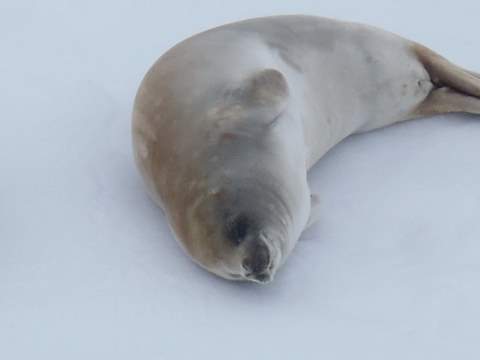
There are four types of seals found within the Antarctic circle ( below 66*33' S latitude) and I have been lucky enough to see all 4 species several times on this trip so far. By far the most common are the crabeater seals. Crabeater seals live on the sea ice, hunting at night and hauling out onto the ice during the day. They do not eat crabs, as their name suggests. Instead, they eat krill which they catch with specially shaped teeth that strain the krill from the water. Right now, the crabeater seals are beginning to molt their fur, and we often see them rolling around on the ice, as if trying to itch their scratchy spots. Their coats are a light brown to grayish brown color. They are the seals most likely to be seen near the edge of the ice; when the Oden goes by they often just lift their heads, watch us pass, then go back to sleep. The pups, born in the spring (Sept. - Nov. down here) are now weaned, and we have seen groups of 3-4 mostly grown pups playing around, sliding and chasing on the ice.
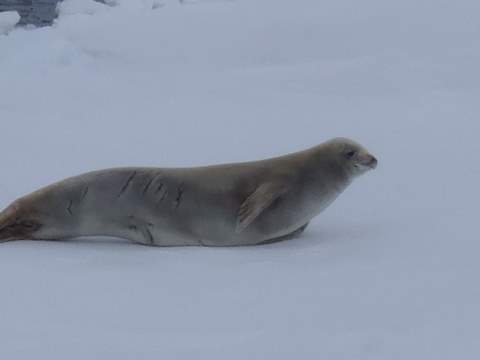
Leopard seals are the largest of the Antarctic seals, and are known to be the most aggressive. Most adult crabeater seals bear the scars of leopard seal attacks. We were lucky enough to see, on two different occasions, a mother leopard seal with her pup. This has rarely ever been observed before! The leopard seal is darker gray on the top of its body, and lighter gray with spots on the throat, aides, and belly. They have a long sleek body and a very large head and mouth. We have seen them several times on the ice as the ship moves by.
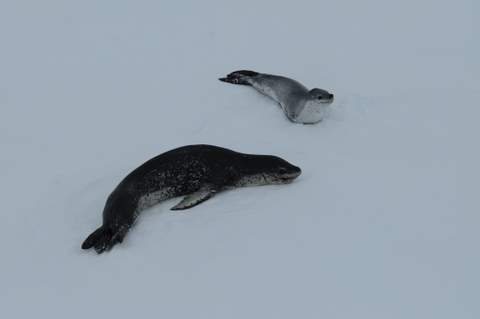
I was surprised to see Ross seals several different times so far on this expedition.. Ross seals are reported to be the rarest of the seals down here, and are found in areas of dense sea ice. They were easy to distinguish from the other seals because they have very thick necks. They almost seem to have no neck at all, just a head on their body! Like the other seals, they are darker on top and lighter on the undersides of their bodies, but they also have some dark streaks on their neck and throat area. They are very vocal, making a variety of grunts and whistles. I observed this first hand when I saw this seal close up with the Oden's seal research team. Keep reading for more about that adventure.
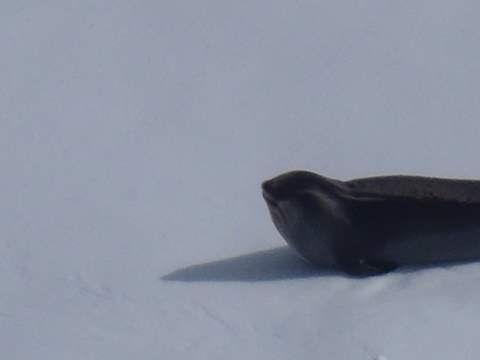
Weddell seals are the seals we have just started seeing as we travel farther south west. They are a spotted dark gray color and their bodies are very round, with tiny heads. They are the deepest diving seals, with dives over 2000 feet deep commonly reported. They are gentle and easy to approach on land, so they have been studied more than the other Antarctic seals. They utilize breathing holes in the ice, often keeping the holes open by scraping the ice with their teeth. I hope we will see more of them as we continue sailing toward McMurdo Station.
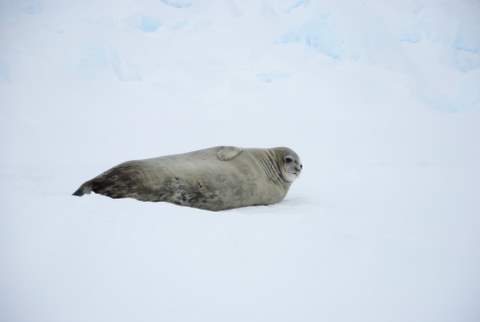
On board the Oden, there is a team of three researchers, Karin Harding, Ollie Karlsson, and Jonas Teilmann, who are studying the seals in the Antarctic. They are collecting blood, hair, skin, blubber, and nasal and anal swabs, as well as physical measurements of size and weight. Their studies are focused on the potential role of infectious diseases in seals. Below is their official project description:
Dynamics and evolution of epidemic diseases in Antarctic and Arctic seals
*Since Antarctic seal species have not been exposed to exploitation for more than 50 years, most populations are expected to have reached their asymptotic population sizes, often termed carrying capacity (K). Fluctuations in population numbers are in such cases often linked to food limitation, predation, disease, or catastrophic events leading to mass mortality. Such events have been documented in the 1950s, when a majority of crabeater seals in investigated areas died. Serum samples collected during the SWEDARP expedition in 1989 showed that the likely cause for the mass mortality was a canine distemper epidemic, that seem to have circulated among crabeater seals and leopard seals ever since. We run a program focusing on the potential role of infectious diseases for the population dynamics of Antarctic seals. A general core issue is to explore processes involved in the evolution of disease resistance, where the epidemiology and immunogenetics of canine distemper in the Antarctic seals will be investigated in parallel with phocine distemper in Arctic and North Sea seals.
77 seal samples were collected during the 2008-2009 expedition along the ship track from 90 degree west to 165 degree east. To increase the sample size, more blood and tissue samples (biopsies) from crabeater, weddell, leopard, and ross seals will be collected during the 2010-2011 cruise in December-January. In 2008-2009 samples were mainly taken from a zodiac or from skiing/walking on the ice floes, in 2010-2011 a helicopter is also available and facilitate easy access to Weddell and Ross seals that tend to haulout further into dense pack ice and on the middle of the large ice floes while crabeater and leopard seals haul out closer to the edge of the floes in loose pack ice. All samples will be used for analysis of epidemiological diseases and current heath status. Nasal and anal swabs for bacteriological and virological analyses will be taken from all seals. Seals are sampled opportunistically along the cruise track as during the 2008-2009 expedition. Most seals will be sedated using Zoletil injected by a dart from an air pressure gun. After 10 min the seals will be caught by pole nets and handled for 15-30 min. For some seals only a biopsy will be taken using an air pressure gun. Our aim is to sample 200 seals.
In addition to the seal project, skin biopsies, including a small (0.5 g) blubber sample, of whales will also be taken opportunistically along the cruise track. The blubber (from both seals and whales) will be analyzed for contaminants by our American collaborator Rececca Dickhut (also participating on the 2010-2011 cruise). The skin is used for genetic DNA analysis on stock structure. Skin biopsies are taken using an air pressure gun when whales are close to a lead or from the zodiac. These are standard methods for sampling whales, which we are very familiar with. We intend to sample minke whales, humpback whales and killer whales, where numbers will depend on availability of whales.*
A few days ago, just as the Oden was maneuvering next to an ice floe to be moored for an ice station, I was up on the bridge when Captain Mattias Peterson pointed out a seal he thought may be a leopard seal. Ice Team member Brent and myself each grabbed out binoculars for a better look. We could see a large, dark seal with a thick neck who had just climbed out of the water onto the ice. It was not a leopard sea a Ross seal, startled by the ship, heading towards the center of the very large floe. The seal team decided they would go out on cross country skis to try to catch it for tissue sampling and measurement. They invited me to come out with them and I jumped at the chance!
The seal team had brought their own cross country skis with them, and there were a few seats of boots and skis owned the ship. I found the smallest pair of boots (probably a men's size 9-10 - I wear a woman's size 7 1/2) and I stuffed the toes with paper towels, put in extra insoles borrowed from my tennis shoes, put on my thickest socks, and I was ready to ski! The seal teams carried out their supplies in a large sled - a large net with poles on two sides, sampling supplies, tranquilizer gun and darts, and a large tripod and scale for weighing the seal. I have cross country skied a few times, but I knew the seal team members were all more experienced skiers than me. I figured I would just try to keep up.
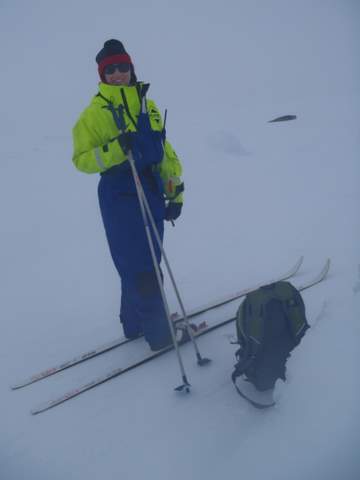
It turns out I was pretty good on the cross country skis. I followed the 3 seal team members, helicopter pilot Sven, and Swedish teacher Caroline out toward the seal, who was about 400 meters or so out towards the middle of the floe. The team signaled us to stay back and Jonas slowly walked a large circle around the seal, assessing its physical condition and estimating its weight for the tranquilizer dosage. The seal lifted its head back with its throat inflated, looking quite large and formidible.
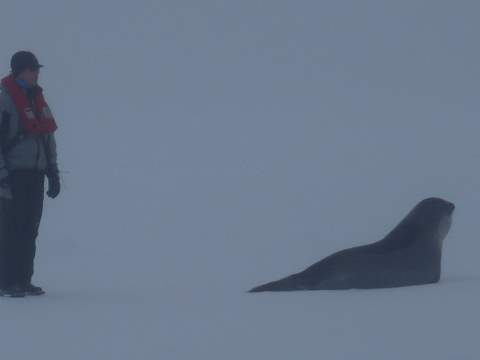
Jonas quickly used an air pressure gun to shoot the seal with a tranquilizer dart . It was easy to see the bright pink tassel of the dart embedded in the seal's flank. The seal moved away from the team, wriggling on his belly, but stopped after a few minutes. The seal team approached with their net and caught the large seal by draping the net over its body lengthwise and rolling the seal into the net, then tying the two net poles together, effectively immobilizing the animal. One person steadied the seal's body while the other team members took the necessary samples. Blood was drawn from a vein near the tail, as well as a skin biopsy, hair samples were cut, nasal and anal swabs were taken with long cotton swabs. Then the team motioned me to come closer, until I was about 3 meters from the captive seal. I could hear him making a "hut, hut, hut" sound, alternating with a higher whistling sound. Ross seals are very vocal, making a wide variety of noises, and this big one was definitely expressing his displeasure in the whole situation.
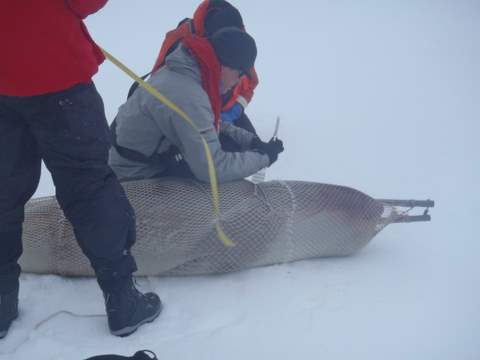
Finally, the team set up the tripod to measure the seal. The tripod legs were placed around the seal and a pulley system attached to the top. A digital scale was hung from the pulley rope and fastened to the poles of the seal net. Then Karin and Jonas hoisted the seal up until he was off the ground. The weight shown was 194 kg. The pulley and net weigh 3 kg, so the seal's final weight was 191 kg or about 420 pounds!
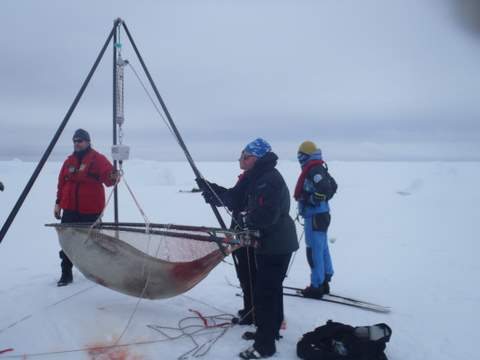
The seal was lowered to the ground, and after we stepped back a little, the net was loosened and the seal quickly, and probably happily, wriggled away as quickly as he could, off toward the middle of the ice floe. I was very happy to see that he seemed none the worse for wear after his ordeal. I'm sure the benefits this rare seal's important contribution to the seal team's project were worth a couple of needle pokes, prods, a little hair cut, and 30 minutes of discomfort.
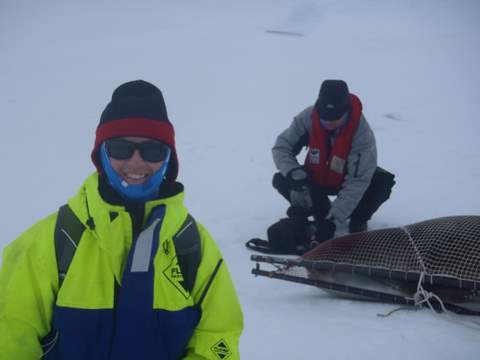
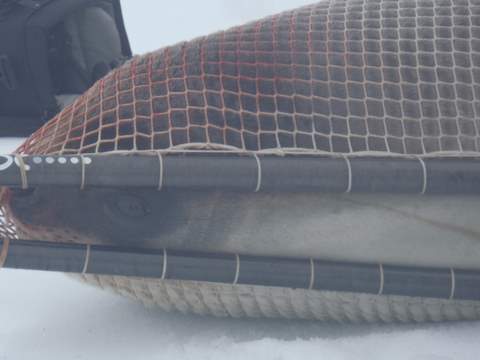
After skiing back to the Oden, I joined my sea ice team for the installation of a 2nd SAMS Sea Ice Mass BalanceThe difference between the mass gained by new ice growth and the amount lost by melting. BuoyA float moored in water or ice to mark a location, warn of danger, or indicate a navigational channel. which will be left on the ice floe to transmit data until the flow breaks apart or melts, or the buoy's batteries die.
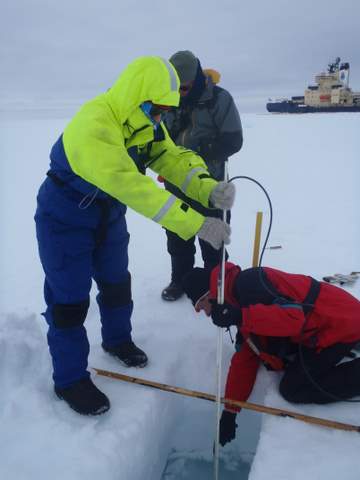
What a great day on the ice! I will never forget cross country skiing on an ice floe in the Antarctic, or being a few feet away from a rare Ross seal with the sea ice research team.
Lesson learned: Seeing wildlife "out in the wild" is much different than seeing it in an aquarium or zoo.


Comments